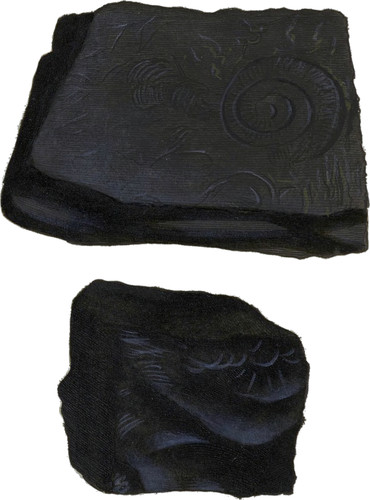 Enlarge
Enlarge
British Mineralogy
Jet
- Class 1. Inflammables.
- Ord. 2. Mixed.
- Gen. 2. Bitumen.
- Spec. 1. Bitumen with oxygenized carbon.
- Spec. Char. Bitumen combined with about 30 per cent. of oxygenized carbon.
- Syn.
- Jet. Kirw. 2. 64.
- Jais. Daubenton 30. De Born 2. 79.
- Varieté du Schlakiges erdpech. Emmerl. 2. 50.
- Jayet. Haüy 3. 324.
- Bitumen Gagas. Linn. Syst. Nat. ed. 13. t. 3. p. 111.
The upper figure represents a curious piece of Jet, remarkable for the remains and impressions of shells about it. It was sent me from Lowestoft by Dr. Smith, President of the Linnean Society. Jet is well known to have been found on the coast at Lowestoft for many years, where amber and curious pebbles are often found. Some fishermen artists of the neighbourhood employ their leisure at convenient seasons to search for them, and form the two first-mentioned into small trinkets. We shall consider true Jet to have passed from the remains of some sort of wood, as the ligneous fibre is in some instances seen; in other specimens it is so condensed and compact as not to be discernible. This substance appears also to be saturated, as it were, with bitumen, insomuch that it readily inflames, losing about 14 grams in 20, with much smoke, and a slight bituminous odour. The remaining cinder, if continued to burn, leaves a very trifling residuum. It is well known to be of the most opaque black (witness the common saying, “black as jet*”); but it will bear a fine polish. Its surface excited by friction possesses the resinous electricity, which distinguishes it from cannel coal, a substance it very much resembles. It may be scratched by common calcareous spar, and will itself scratch amber and gypsum. The fracture is conchoidal, occasionally retaining that of wood. Lustre 3 to 4; transparency 0. Spec. Grav. 1.104 to 1.744. Kirw. It has generally been said to swim on water. Thin pieces, indeed, laid lightly on the water, will float for a short space of time; but at length the water passes over them, and they sink: perhaps some slight trial of this kind might cause the common idea of its swimming. Of many pieces in our possession none wil swim. Linnæus called it Bitumen Gagas, from the river Gages in Lycia, near which it was found. The presence of shells, and the impression of the Cornu-Ammonis, indicate its former less indurated state.
The lower piece has some signs of incumbent strata having been on the upper surface, in an obsolete impression, and also some obscure crystals of carbonate of lime underneath. The fracture is in part largely conchoidal. With some difficulty we may observe the woody stratification. It is truly black. I have a piece where the woody texture is very evident, with small cubic pyrites on the side. With heat and water I decomposed a bit of it, so as very satifactorily to expose its woody structure. It comes very near to the most indurated Bovey coal and surturbrand†, evidently belonging to that division.
- * The streak or powder is always brown.
- † These also produce a brown powder.

